Australian School of Commerce: BSBRSK501 Risk Management Plan for CBA
VerifiedAdded on 2022/10/01
|15
|2523
|30
Report
AI Summary
This report presents a detailed risk management plan and processes implemented at the Commonwealth Bank of Australia (CBA). The report begins with an introduction to CBA and its financial services, followed by an overview of its risk management approach, including scope identification, stakeholder analysis (internal and external), and the identification of potential concerns. A SWOT analysis is conducted to assess CBA's strengths, weaknesses, opportunities, and threats. Critical success factors, goals, and objectives for different areas are outlined, along with the identification of potential risks such as technical attacks and market volatility. The report then delves into the risk management process, including risk identification, likelihood and impact assessment, and the development of action plans for risk treatment. It also covers monitoring, evaluation, and communication processes. Finally, the report includes a sample hazard report form for workplace implementation and references supporting the analysis.
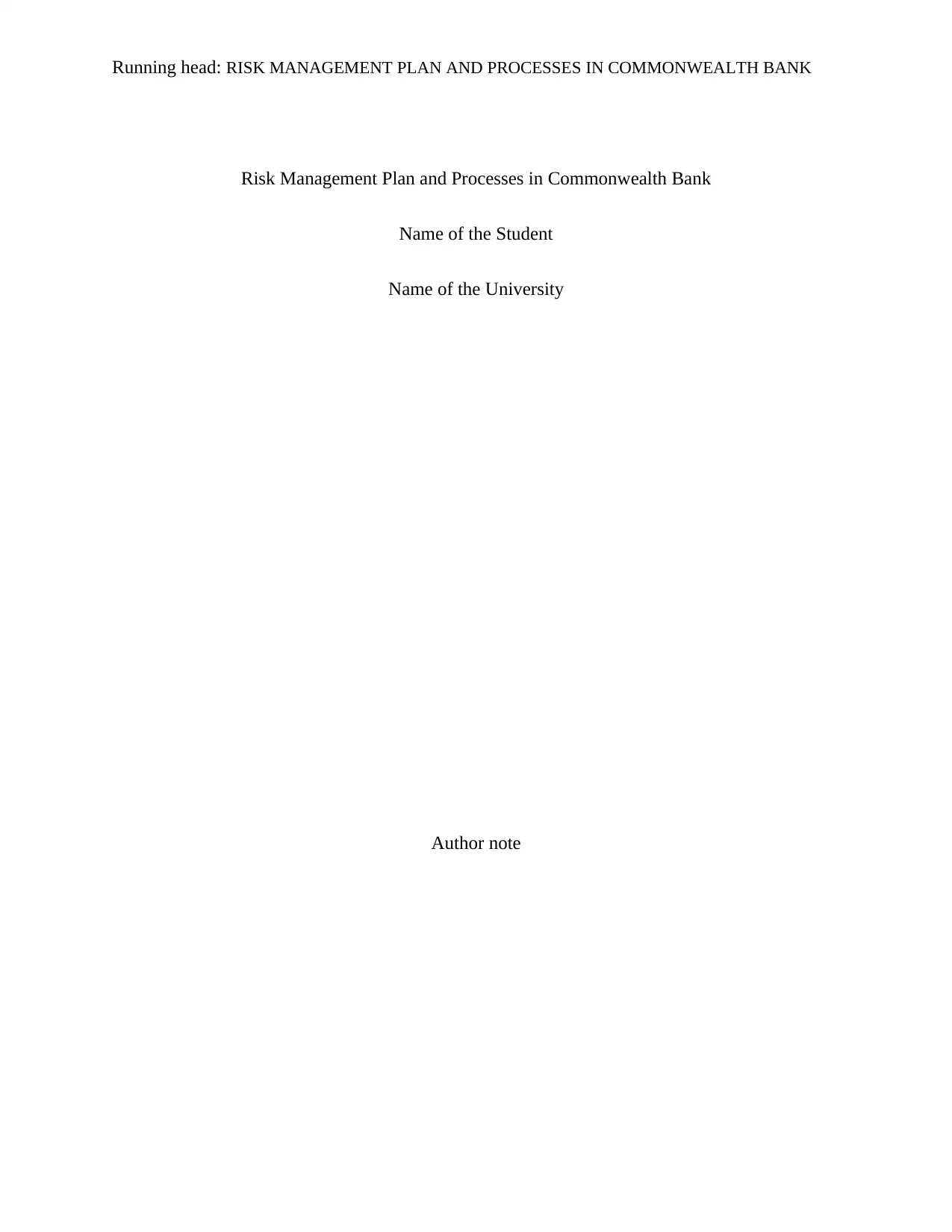
Running head: RISK MANAGEMENT PLAN AND PROCESSES IN COMMONWEALTH BANK
Risk Management Plan and Processes in Commonwealth Bank
Name of the Student
Name of the University
Author note
Risk Management Plan and Processes in Commonwealth Bank
Name of the Student
Name of the University
Author note
Paraphrase This Document
Need a fresh take? Get an instant paraphrase of this document with our AI Paraphraser
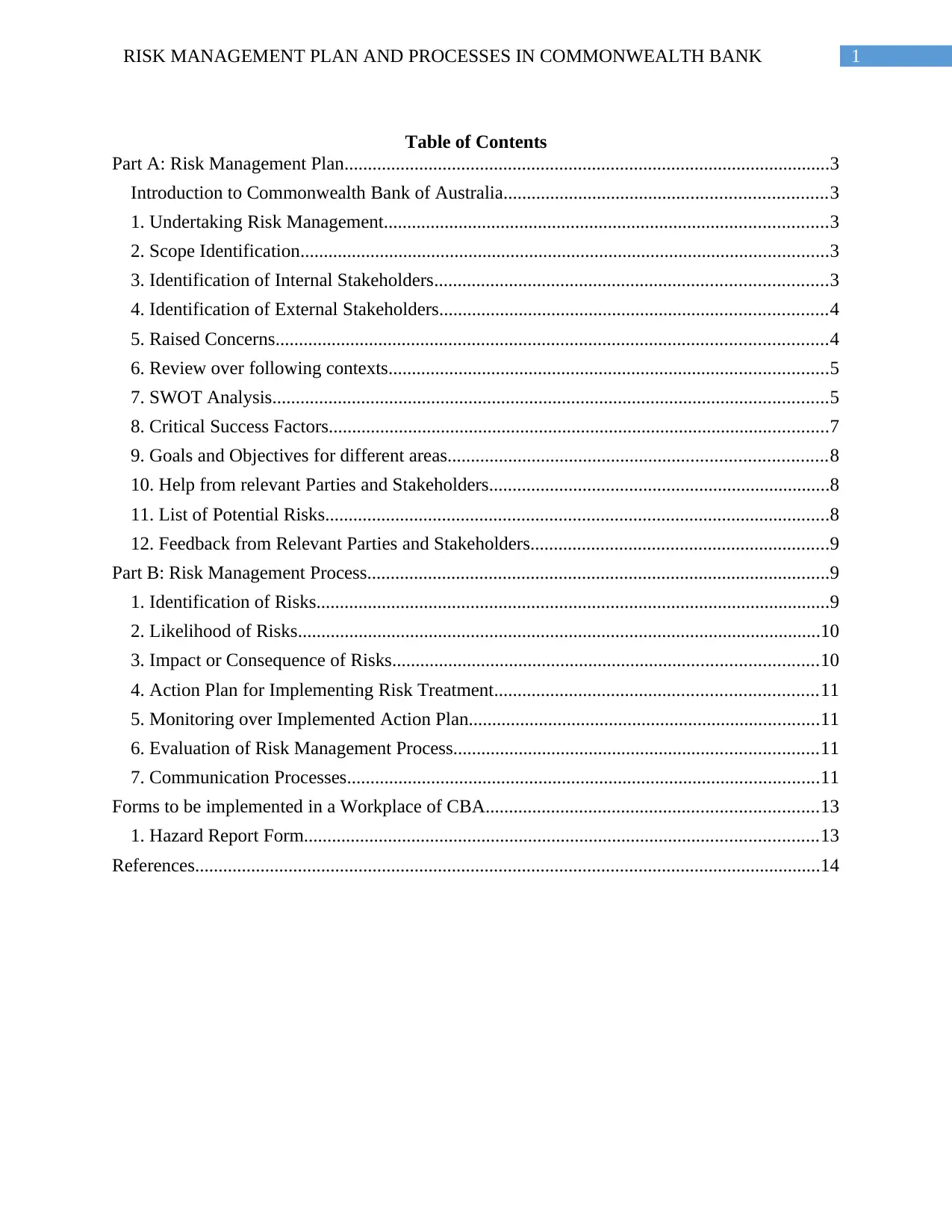
1RISK MANAGEMENT PLAN AND PROCESSES IN COMMONWEALTH BANK
Table of Contents
Part A: Risk Management Plan........................................................................................................3
Introduction to Commonwealth Bank of Australia.....................................................................3
1. Undertaking Risk Management...............................................................................................3
2. Scope Identification.................................................................................................................3
3. Identification of Internal Stakeholders....................................................................................3
4. Identification of External Stakeholders...................................................................................4
5. Raised Concerns......................................................................................................................4
6. Review over following contexts..............................................................................................5
7. SWOT Analysis.......................................................................................................................5
8. Critical Success Factors...........................................................................................................7
9. Goals and Objectives for different areas.................................................................................8
10. Help from relevant Parties and Stakeholders.........................................................................8
11. List of Potential Risks............................................................................................................8
12. Feedback from Relevant Parties and Stakeholders................................................................9
Part B: Risk Management Process...................................................................................................9
1. Identification of Risks..............................................................................................................9
2. Likelihood of Risks................................................................................................................10
3. Impact or Consequence of Risks...........................................................................................10
4. Action Plan for Implementing Risk Treatment.....................................................................11
5. Monitoring over Implemented Action Plan...........................................................................11
6. Evaluation of Risk Management Process..............................................................................11
7. Communication Processes.....................................................................................................11
Forms to be implemented in a Workplace of CBA.......................................................................13
1. Hazard Report Form..............................................................................................................13
References......................................................................................................................................14
Table of Contents
Part A: Risk Management Plan........................................................................................................3
Introduction to Commonwealth Bank of Australia.....................................................................3
1. Undertaking Risk Management...............................................................................................3
2. Scope Identification.................................................................................................................3
3. Identification of Internal Stakeholders....................................................................................3
4. Identification of External Stakeholders...................................................................................4
5. Raised Concerns......................................................................................................................4
6. Review over following contexts..............................................................................................5
7. SWOT Analysis.......................................................................................................................5
8. Critical Success Factors...........................................................................................................7
9. Goals and Objectives for different areas.................................................................................8
10. Help from relevant Parties and Stakeholders.........................................................................8
11. List of Potential Risks............................................................................................................8
12. Feedback from Relevant Parties and Stakeholders................................................................9
Part B: Risk Management Process...................................................................................................9
1. Identification of Risks..............................................................................................................9
2. Likelihood of Risks................................................................................................................10
3. Impact or Consequence of Risks...........................................................................................10
4. Action Plan for Implementing Risk Treatment.....................................................................11
5. Monitoring over Implemented Action Plan...........................................................................11
6. Evaluation of Risk Management Process..............................................................................11
7. Communication Processes.....................................................................................................11
Forms to be implemented in a Workplace of CBA.......................................................................13
1. Hazard Report Form..............................................................................................................13
References......................................................................................................................................14
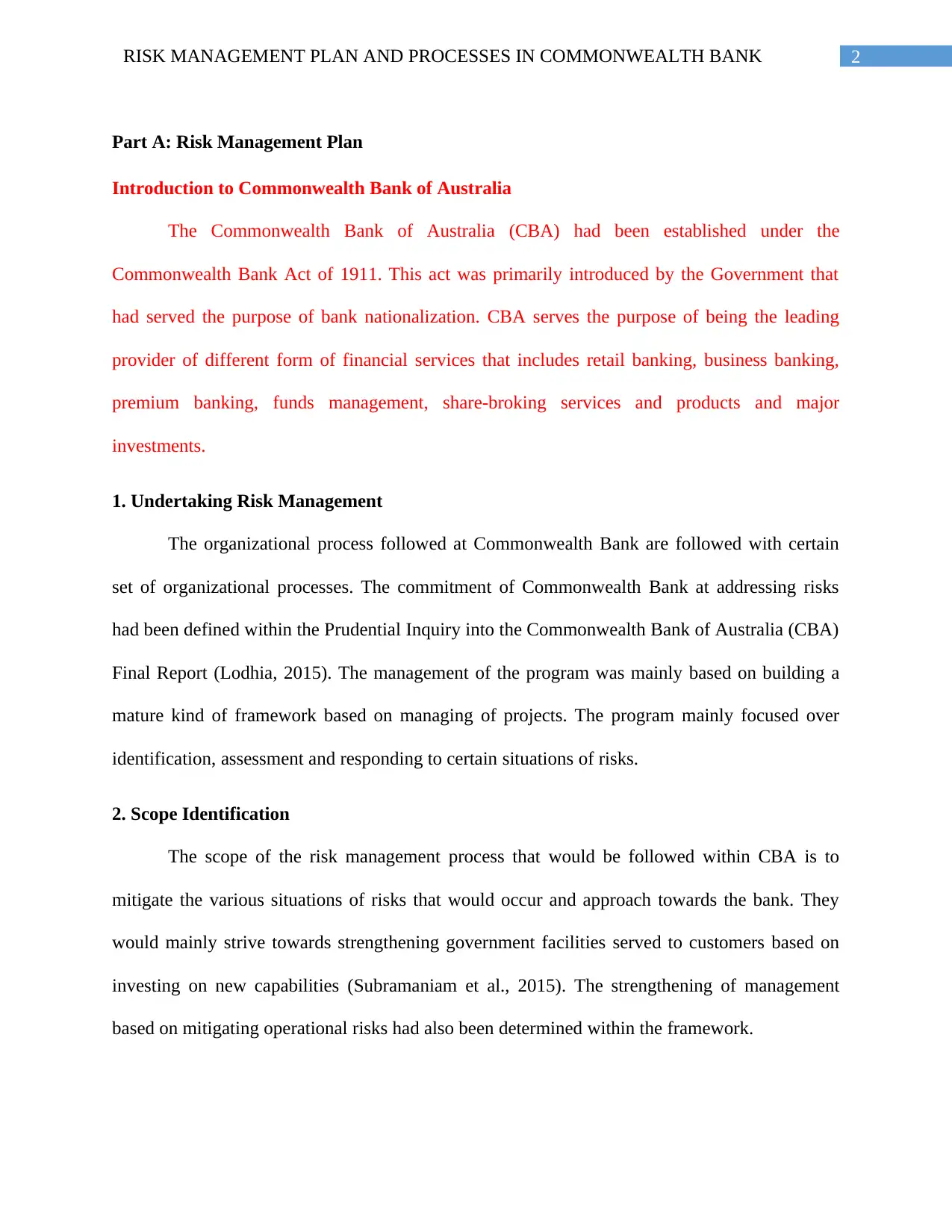
2RISK MANAGEMENT PLAN AND PROCESSES IN COMMONWEALTH BANK
Part A: Risk Management Plan
Introduction to Commonwealth Bank of Australia
The Commonwealth Bank of Australia (CBA) had been established under the
Commonwealth Bank Act of 1911. This act was primarily introduced by the Government that
had served the purpose of bank nationalization. CBA serves the purpose of being the leading
provider of different form of financial services that includes retail banking, business banking,
premium banking, funds management, share-broking services and products and major
investments.
1. Undertaking Risk Management
The organizational process followed at Commonwealth Bank are followed with certain
set of organizational processes. The commitment of Commonwealth Bank at addressing risks
had been defined within the Prudential Inquiry into the Commonwealth Bank of Australia (CBA)
Final Report (Lodhia, 2015). The management of the program was mainly based on building a
mature kind of framework based on managing of projects. The program mainly focused over
identification, assessment and responding to certain situations of risks.
2. Scope Identification
The scope of the risk management process that would be followed within CBA is to
mitigate the various situations of risks that would occur and approach towards the bank. They
would mainly strive towards strengthening government facilities served to customers based on
investing on new capabilities (Subramaniam et al., 2015). The strengthening of management
based on mitigating operational risks had also been determined within the framework.
Part A: Risk Management Plan
Introduction to Commonwealth Bank of Australia
The Commonwealth Bank of Australia (CBA) had been established under the
Commonwealth Bank Act of 1911. This act was primarily introduced by the Government that
had served the purpose of bank nationalization. CBA serves the purpose of being the leading
provider of different form of financial services that includes retail banking, business banking,
premium banking, funds management, share-broking services and products and major
investments.
1. Undertaking Risk Management
The organizational process followed at Commonwealth Bank are followed with certain
set of organizational processes. The commitment of Commonwealth Bank at addressing risks
had been defined within the Prudential Inquiry into the Commonwealth Bank of Australia (CBA)
Final Report (Lodhia, 2015). The management of the program was mainly based on building a
mature kind of framework based on managing of projects. The program mainly focused over
identification, assessment and responding to certain situations of risks.
2. Scope Identification
The scope of the risk management process that would be followed within CBA is to
mitigate the various situations of risks that would occur and approach towards the bank. They
would mainly strive towards strengthening government facilities served to customers based on
investing on new capabilities (Subramaniam et al., 2015). The strengthening of management
based on mitigating operational risks had also been determined within the framework.
⊘ This is a preview!⊘
Do you want full access?
Subscribe today to unlock all pages.

Trusted by 1+ million students worldwide
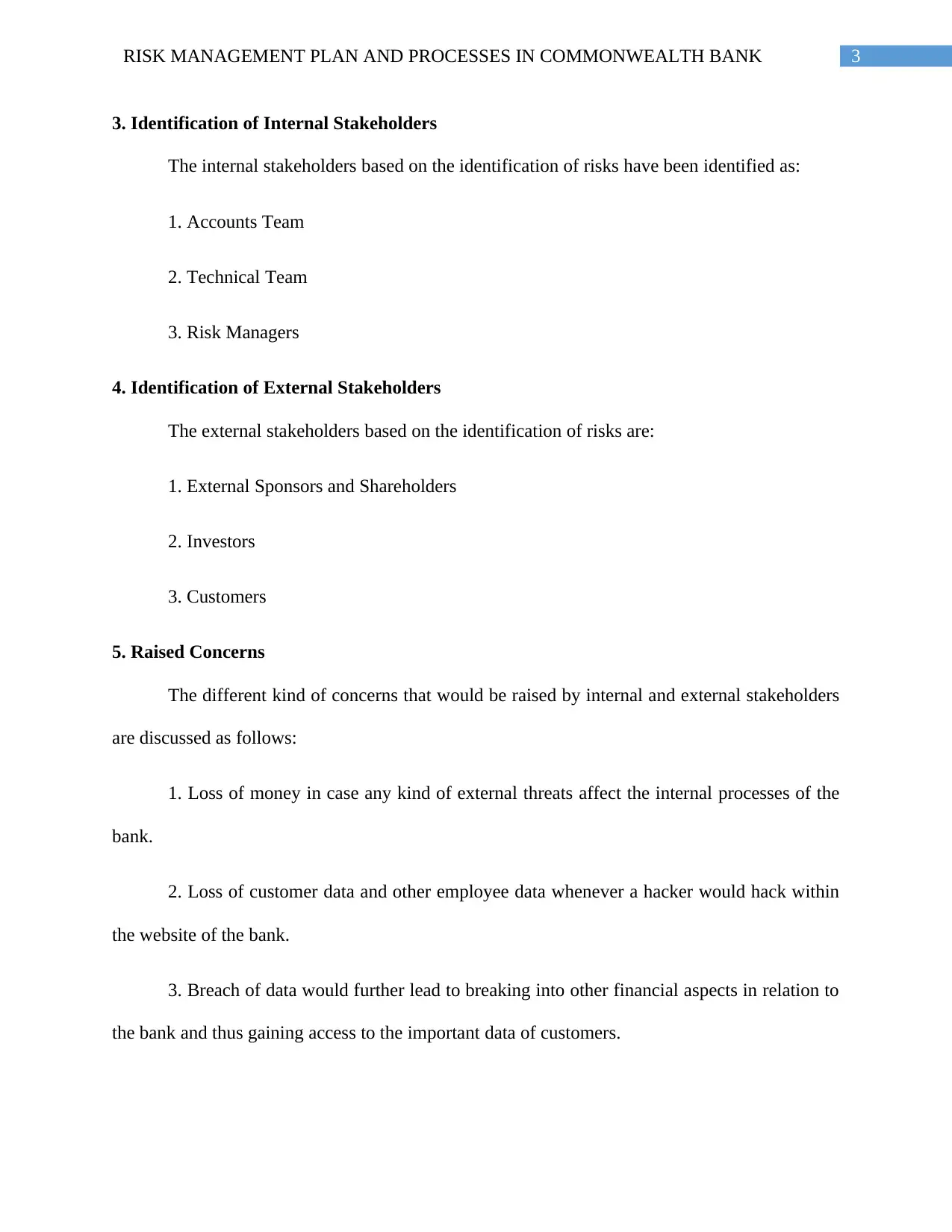
3RISK MANAGEMENT PLAN AND PROCESSES IN COMMONWEALTH BANK
3. Identification of Internal Stakeholders
The internal stakeholders based on the identification of risks have been identified as:
1. Accounts Team
2. Technical Team
3. Risk Managers
4. Identification of External Stakeholders
The external stakeholders based on the identification of risks are:
1. External Sponsors and Shareholders
2. Investors
3. Customers
5. Raised Concerns
The different kind of concerns that would be raised by internal and external stakeholders
are discussed as follows:
1. Loss of money in case any kind of external threats affect the internal processes of the
bank.
2. Loss of customer data and other employee data whenever a hacker would hack within
the website of the bank.
3. Breach of data would further lead to breaking into other financial aspects in relation to
the bank and thus gaining access to the important data of customers.
3. Identification of Internal Stakeholders
The internal stakeholders based on the identification of risks have been identified as:
1. Accounts Team
2. Technical Team
3. Risk Managers
4. Identification of External Stakeholders
The external stakeholders based on the identification of risks are:
1. External Sponsors and Shareholders
2. Investors
3. Customers
5. Raised Concerns
The different kind of concerns that would be raised by internal and external stakeholders
are discussed as follows:
1. Loss of money in case any kind of external threats affect the internal processes of the
bank.
2. Loss of customer data and other employee data whenever a hacker would hack within
the website of the bank.
3. Breach of data would further lead to breaking into other financial aspects in relation to
the bank and thus gaining access to the important data of customers.
Paraphrase This Document
Need a fresh take? Get an instant paraphrase of this document with our AI Paraphraser
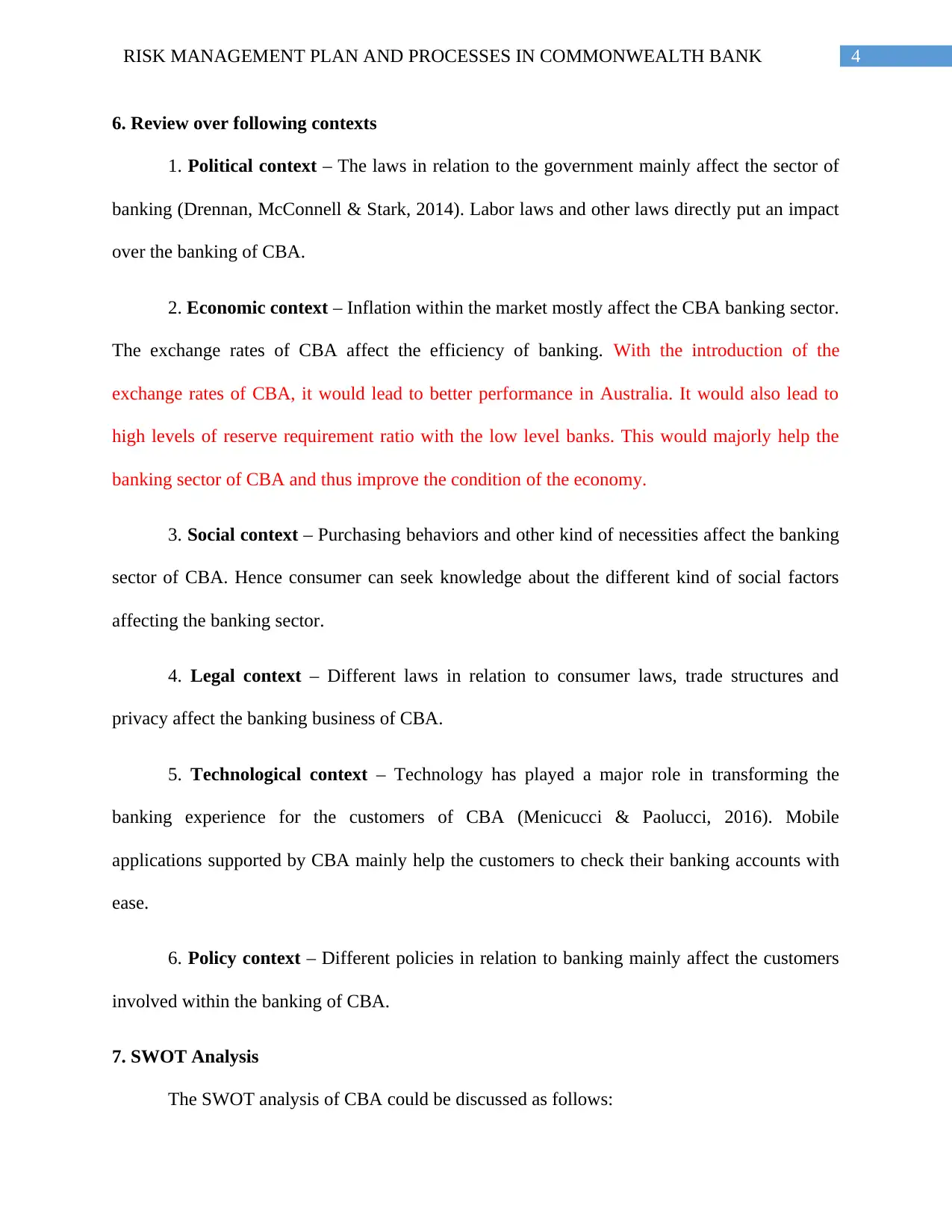
4RISK MANAGEMENT PLAN AND PROCESSES IN COMMONWEALTH BANK
6. Review over following contexts
1. Political context – The laws in relation to the government mainly affect the sector of
banking (Drennan, McConnell & Stark, 2014). Labor laws and other laws directly put an impact
over the banking of CBA.
2. Economic context – Inflation within the market mostly affect the CBA banking sector.
The exchange rates of CBA affect the efficiency of banking. With the introduction of the
exchange rates of CBA, it would lead to better performance in Australia. It would also lead to
high levels of reserve requirement ratio with the low level banks. This would majorly help the
banking sector of CBA and thus improve the condition of the economy.
3. Social context – Purchasing behaviors and other kind of necessities affect the banking
sector of CBA. Hence consumer can seek knowledge about the different kind of social factors
affecting the banking sector.
4. Legal context – Different laws in relation to consumer laws, trade structures and
privacy affect the banking business of CBA.
5. Technological context – Technology has played a major role in transforming the
banking experience for the customers of CBA (Menicucci & Paolucci, 2016). Mobile
applications supported by CBA mainly help the customers to check their banking accounts with
ease.
6. Policy context – Different policies in relation to banking mainly affect the customers
involved within the banking of CBA.
7. SWOT Analysis
The SWOT analysis of CBA could be discussed as follows:
6. Review over following contexts
1. Political context – The laws in relation to the government mainly affect the sector of
banking (Drennan, McConnell & Stark, 2014). Labor laws and other laws directly put an impact
over the banking of CBA.
2. Economic context – Inflation within the market mostly affect the CBA banking sector.
The exchange rates of CBA affect the efficiency of banking. With the introduction of the
exchange rates of CBA, it would lead to better performance in Australia. It would also lead to
high levels of reserve requirement ratio with the low level banks. This would majorly help the
banking sector of CBA and thus improve the condition of the economy.
3. Social context – Purchasing behaviors and other kind of necessities affect the banking
sector of CBA. Hence consumer can seek knowledge about the different kind of social factors
affecting the banking sector.
4. Legal context – Different laws in relation to consumer laws, trade structures and
privacy affect the banking business of CBA.
5. Technological context – Technology has played a major role in transforming the
banking experience for the customers of CBA (Menicucci & Paolucci, 2016). Mobile
applications supported by CBA mainly help the customers to check their banking accounts with
ease.
6. Policy context – Different policies in relation to banking mainly affect the customers
involved within the banking of CBA.
7. SWOT Analysis
The SWOT analysis of CBA could be discussed as follows:
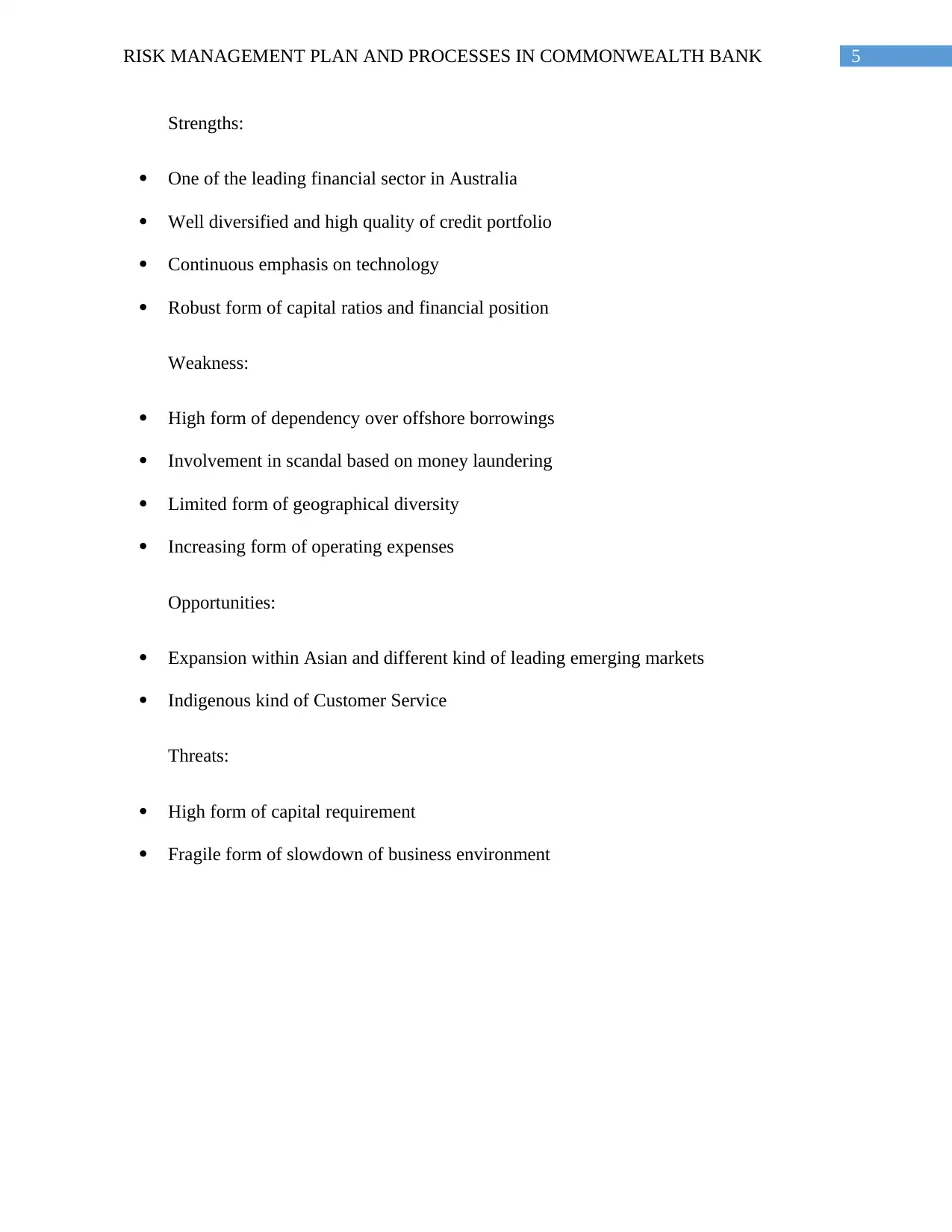
5RISK MANAGEMENT PLAN AND PROCESSES IN COMMONWEALTH BANK
Strengths:
One of the leading financial sector in Australia
Well diversified and high quality of credit portfolio
Continuous emphasis on technology
Robust form of capital ratios and financial position
Weakness:
High form of dependency over offshore borrowings
Involvement in scandal based on money laundering
Limited form of geographical diversity
Increasing form of operating expenses
Opportunities:
Expansion within Asian and different kind of leading emerging markets
Indigenous kind of Customer Service
Threats:
High form of capital requirement
Fragile form of slowdown of business environment
Strengths:
One of the leading financial sector in Australia
Well diversified and high quality of credit portfolio
Continuous emphasis on technology
Robust form of capital ratios and financial position
Weakness:
High form of dependency over offshore borrowings
Involvement in scandal based on money laundering
Limited form of geographical diversity
Increasing form of operating expenses
Opportunities:
Expansion within Asian and different kind of leading emerging markets
Indigenous kind of Customer Service
Threats:
High form of capital requirement
Fragile form of slowdown of business environment
⊘ This is a preview!⊘
Do you want full access?
Subscribe today to unlock all pages.

Trusted by 1+ million students worldwide
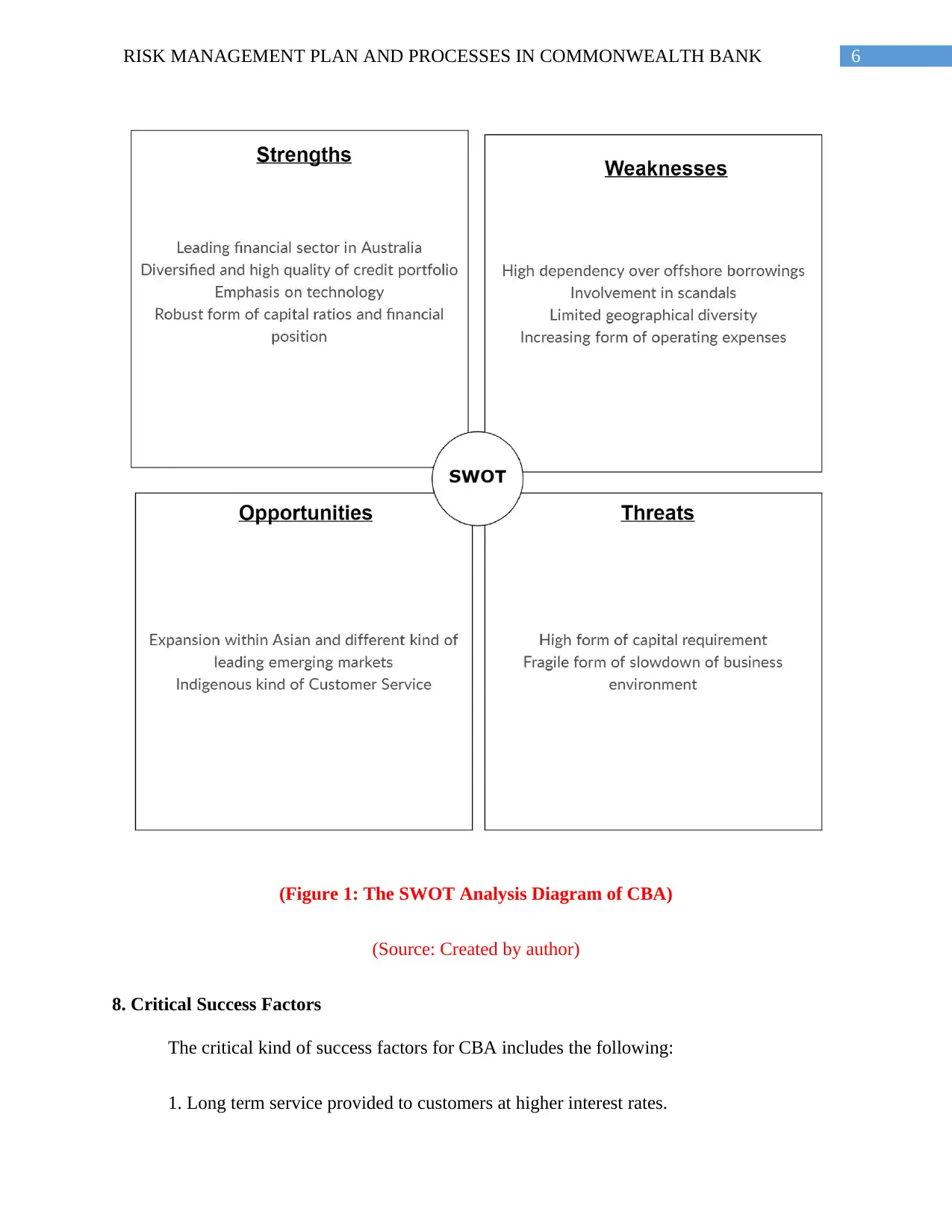
6RISK MANAGEMENT PLAN AND PROCESSES IN COMMONWEALTH BANK
(Figure 1: The SWOT Analysis Diagram of CBA)
(Source: Created by author)
8. Critical Success Factors
The critical kind of success factors for CBA includes the following:
1. Long term service provided to customers at higher interest rates.
(Figure 1: The SWOT Analysis Diagram of CBA)
(Source: Created by author)
8. Critical Success Factors
The critical kind of success factors for CBA includes the following:
1. Long term service provided to customers at higher interest rates.
Paraphrase This Document
Need a fresh take? Get an instant paraphrase of this document with our AI Paraphraser
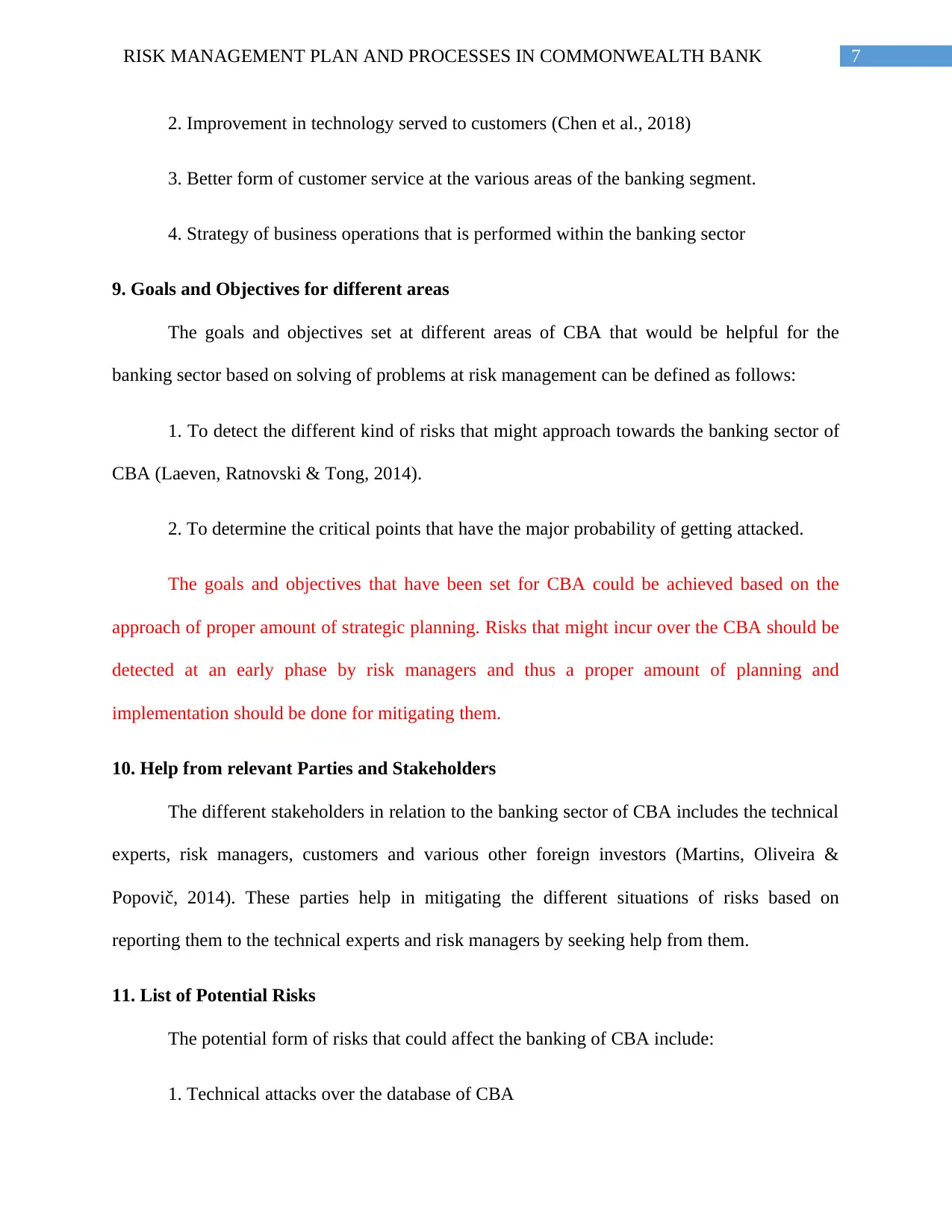
7RISK MANAGEMENT PLAN AND PROCESSES IN COMMONWEALTH BANK
2. Improvement in technology served to customers (Chen et al., 2018)
3. Better form of customer service at the various areas of the banking segment.
4. Strategy of business operations that is performed within the banking sector
9. Goals and Objectives for different areas
The goals and objectives set at different areas of CBA that would be helpful for the
banking sector based on solving of problems at risk management can be defined as follows:
1. To detect the different kind of risks that might approach towards the banking sector of
CBA (Laeven, Ratnovski & Tong, 2014).
2. To determine the critical points that have the major probability of getting attacked.
The goals and objectives that have been set for CBA could be achieved based on the
approach of proper amount of strategic planning. Risks that might incur over the CBA should be
detected at an early phase by risk managers and thus a proper amount of planning and
implementation should be done for mitigating them.
10. Help from relevant Parties and Stakeholders
The different stakeholders in relation to the banking sector of CBA includes the technical
experts, risk managers, customers and various other foreign investors (Martins, Oliveira &
Popovič, 2014). These parties help in mitigating the different situations of risks based on
reporting them to the technical experts and risk managers by seeking help from them.
11. List of Potential Risks
The potential form of risks that could affect the banking of CBA include:
1. Technical attacks over the database of CBA
2. Improvement in technology served to customers (Chen et al., 2018)
3. Better form of customer service at the various areas of the banking segment.
4. Strategy of business operations that is performed within the banking sector
9. Goals and Objectives for different areas
The goals and objectives set at different areas of CBA that would be helpful for the
banking sector based on solving of problems at risk management can be defined as follows:
1. To detect the different kind of risks that might approach towards the banking sector of
CBA (Laeven, Ratnovski & Tong, 2014).
2. To determine the critical points that have the major probability of getting attacked.
The goals and objectives that have been set for CBA could be achieved based on the
approach of proper amount of strategic planning. Risks that might incur over the CBA should be
detected at an early phase by risk managers and thus a proper amount of planning and
implementation should be done for mitigating them.
10. Help from relevant Parties and Stakeholders
The different stakeholders in relation to the banking sector of CBA includes the technical
experts, risk managers, customers and various other foreign investors (Martins, Oliveira &
Popovič, 2014). These parties help in mitigating the different situations of risks based on
reporting them to the technical experts and risk managers by seeking help from them.
11. List of Potential Risks
The potential form of risks that could affect the banking of CBA include:
1. Technical attacks over the database of CBA
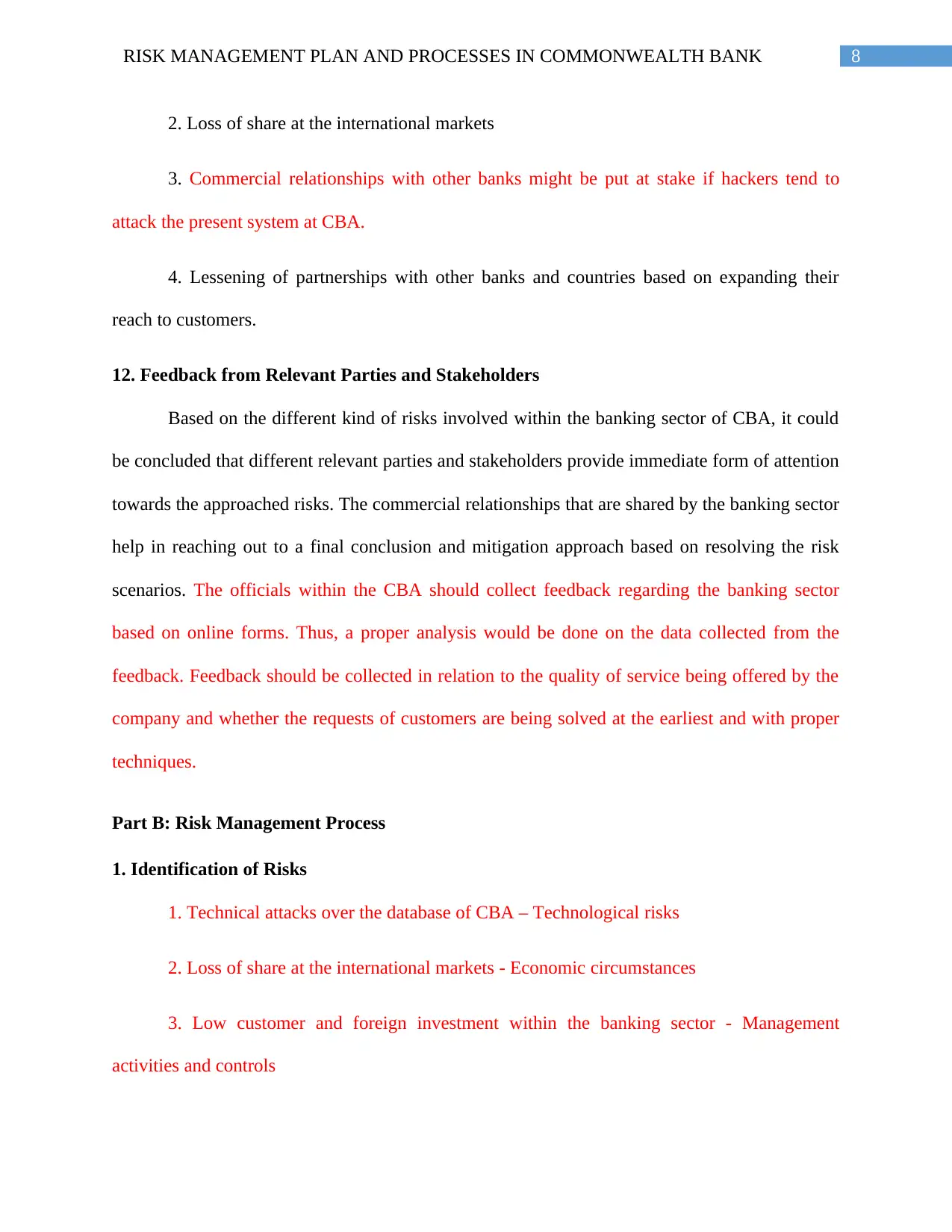
8RISK MANAGEMENT PLAN AND PROCESSES IN COMMONWEALTH BANK
2. Loss of share at the international markets
3. Commercial relationships with other banks might be put at stake if hackers tend to
attack the present system at CBA.
4. Lessening of partnerships with other banks and countries based on expanding their
reach to customers.
12. Feedback from Relevant Parties and Stakeholders
Based on the different kind of risks involved within the banking sector of CBA, it could
be concluded that different relevant parties and stakeholders provide immediate form of attention
towards the approached risks. The commercial relationships that are shared by the banking sector
help in reaching out to a final conclusion and mitigation approach based on resolving the risk
scenarios. The officials within the CBA should collect feedback regarding the banking sector
based on online forms. Thus, a proper analysis would be done on the data collected from the
feedback. Feedback should be collected in relation to the quality of service being offered by the
company and whether the requests of customers are being solved at the earliest and with proper
techniques.
Part B: Risk Management Process
1. Identification of Risks
1. Technical attacks over the database of CBA – Technological risks
2. Loss of share at the international markets - Economic circumstances
3. Low customer and foreign investment within the banking sector - Management
activities and controls
2. Loss of share at the international markets
3. Commercial relationships with other banks might be put at stake if hackers tend to
attack the present system at CBA.
4. Lessening of partnerships with other banks and countries based on expanding their
reach to customers.
12. Feedback from Relevant Parties and Stakeholders
Based on the different kind of risks involved within the banking sector of CBA, it could
be concluded that different relevant parties and stakeholders provide immediate form of attention
towards the approached risks. The commercial relationships that are shared by the banking sector
help in reaching out to a final conclusion and mitigation approach based on resolving the risk
scenarios. The officials within the CBA should collect feedback regarding the banking sector
based on online forms. Thus, a proper analysis would be done on the data collected from the
feedback. Feedback should be collected in relation to the quality of service being offered by the
company and whether the requests of customers are being solved at the earliest and with proper
techniques.
Part B: Risk Management Process
1. Identification of Risks
1. Technical attacks over the database of CBA – Technological risks
2. Loss of share at the international markets - Economic circumstances
3. Low customer and foreign investment within the banking sector - Management
activities and controls
⊘ This is a preview!⊘
Do you want full access?
Subscribe today to unlock all pages.

Trusted by 1+ million students worldwide
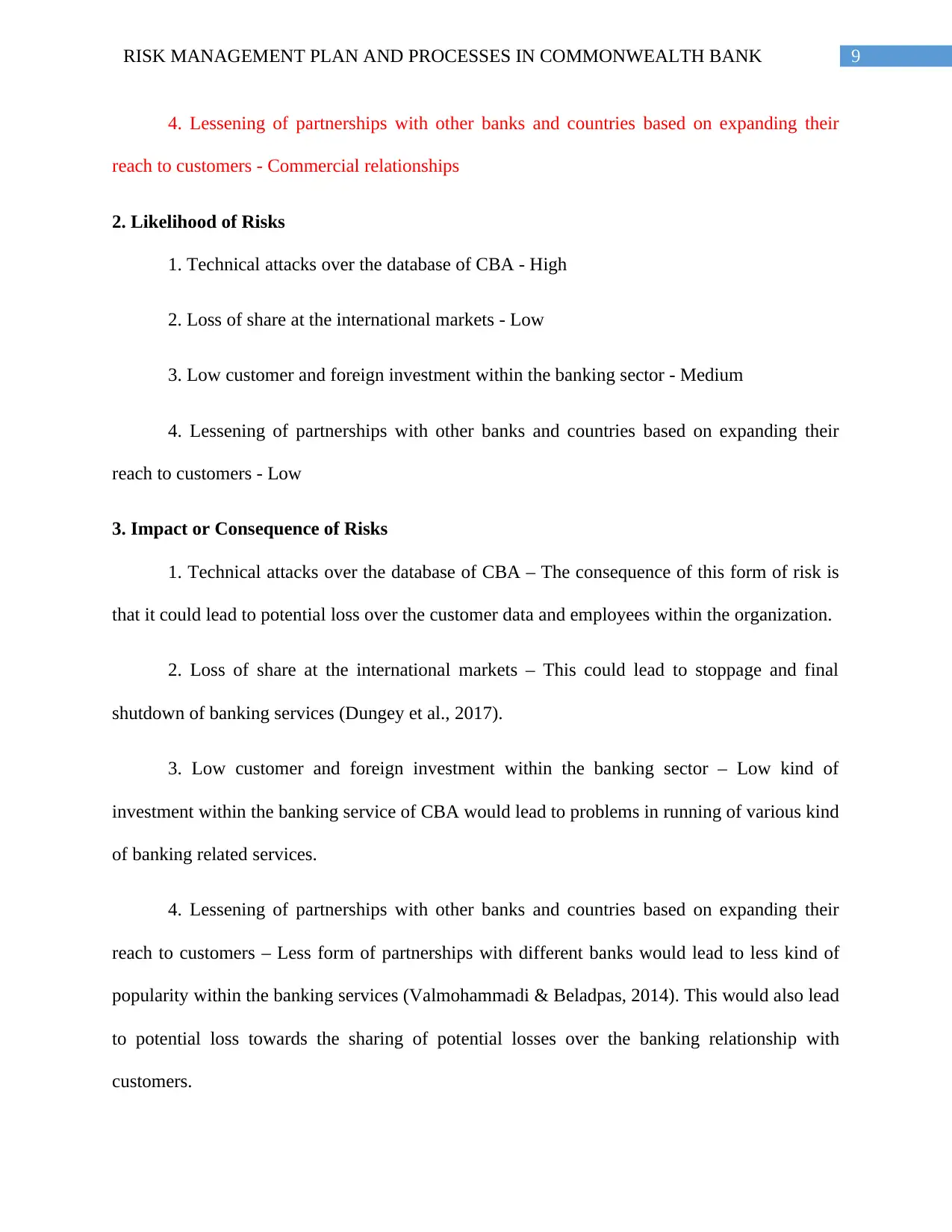
9RISK MANAGEMENT PLAN AND PROCESSES IN COMMONWEALTH BANK
4. Lessening of partnerships with other banks and countries based on expanding their
reach to customers - Commercial relationships
2. Likelihood of Risks
1. Technical attacks over the database of CBA - High
2. Loss of share at the international markets - Low
3. Low customer and foreign investment within the banking sector - Medium
4. Lessening of partnerships with other banks and countries based on expanding their
reach to customers - Low
3. Impact or Consequence of Risks
1. Technical attacks over the database of CBA – The consequence of this form of risk is
that it could lead to potential loss over the customer data and employees within the organization.
2. Loss of share at the international markets – This could lead to stoppage and final
shutdown of banking services (Dungey et al., 2017).
3. Low customer and foreign investment within the banking sector – Low kind of
investment within the banking service of CBA would lead to problems in running of various kind
of banking related services.
4. Lessening of partnerships with other banks and countries based on expanding their
reach to customers – Less form of partnerships with different banks would lead to less kind of
popularity within the banking services (Valmohammadi & Beladpas, 2014). This would also lead
to potential loss towards the sharing of potential losses over the banking relationship with
customers.
4. Lessening of partnerships with other banks and countries based on expanding their
reach to customers - Commercial relationships
2. Likelihood of Risks
1. Technical attacks over the database of CBA - High
2. Loss of share at the international markets - Low
3. Low customer and foreign investment within the banking sector - Medium
4. Lessening of partnerships with other banks and countries based on expanding their
reach to customers - Low
3. Impact or Consequence of Risks
1. Technical attacks over the database of CBA – The consequence of this form of risk is
that it could lead to potential loss over the customer data and employees within the organization.
2. Loss of share at the international markets – This could lead to stoppage and final
shutdown of banking services (Dungey et al., 2017).
3. Low customer and foreign investment within the banking sector – Low kind of
investment within the banking service of CBA would lead to problems in running of various kind
of banking related services.
4. Lessening of partnerships with other banks and countries based on expanding their
reach to customers – Less form of partnerships with different banks would lead to less kind of
popularity within the banking services (Valmohammadi & Beladpas, 2014). This would also lead
to potential loss towards the sharing of potential losses over the banking relationship with
customers.
Paraphrase This Document
Need a fresh take? Get an instant paraphrase of this document with our AI Paraphraser
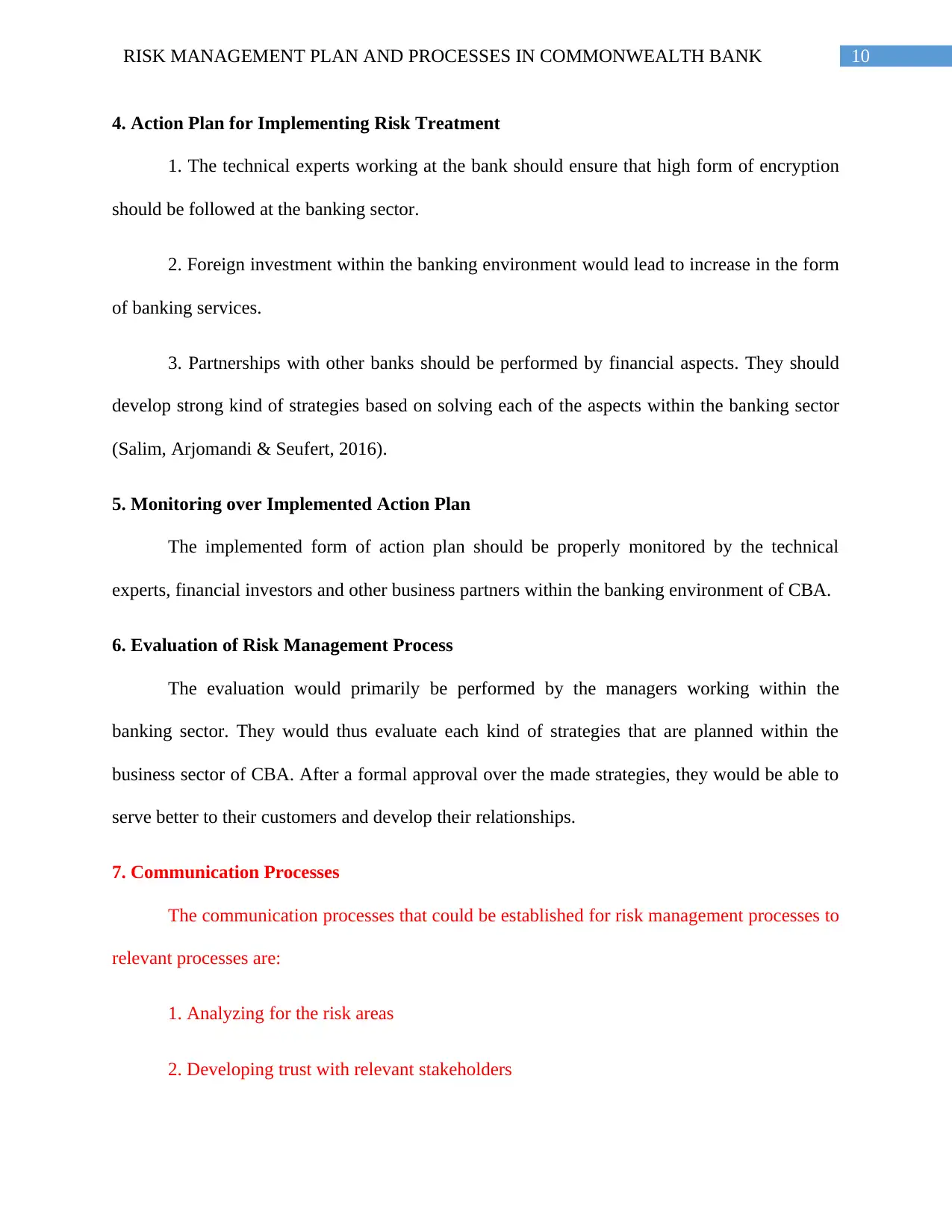
10RISK MANAGEMENT PLAN AND PROCESSES IN COMMONWEALTH BANK
4. Action Plan for Implementing Risk Treatment
1. The technical experts working at the bank should ensure that high form of encryption
should be followed at the banking sector.
2. Foreign investment within the banking environment would lead to increase in the form
of banking services.
3. Partnerships with other banks should be performed by financial aspects. They should
develop strong kind of strategies based on solving each of the aspects within the banking sector
(Salim, Arjomandi & Seufert, 2016).
5. Monitoring over Implemented Action Plan
The implemented form of action plan should be properly monitored by the technical
experts, financial investors and other business partners within the banking environment of CBA.
6. Evaluation of Risk Management Process
The evaluation would primarily be performed by the managers working within the
banking sector. They would thus evaluate each kind of strategies that are planned within the
business sector of CBA. After a formal approval over the made strategies, they would be able to
serve better to their customers and develop their relationships.
7. Communication Processes
The communication processes that could be established for risk management processes to
relevant processes are:
1. Analyzing for the risk areas
2. Developing trust with relevant stakeholders
4. Action Plan for Implementing Risk Treatment
1. The technical experts working at the bank should ensure that high form of encryption
should be followed at the banking sector.
2. Foreign investment within the banking environment would lead to increase in the form
of banking services.
3. Partnerships with other banks should be performed by financial aspects. They should
develop strong kind of strategies based on solving each of the aspects within the banking sector
(Salim, Arjomandi & Seufert, 2016).
5. Monitoring over Implemented Action Plan
The implemented form of action plan should be properly monitored by the technical
experts, financial investors and other business partners within the banking environment of CBA.
6. Evaluation of Risk Management Process
The evaluation would primarily be performed by the managers working within the
banking sector. They would thus evaluate each kind of strategies that are planned within the
business sector of CBA. After a formal approval over the made strategies, they would be able to
serve better to their customers and develop their relationships.
7. Communication Processes
The communication processes that could be established for risk management processes to
relevant processes are:
1. Analyzing for the risk areas
2. Developing trust with relevant stakeholders
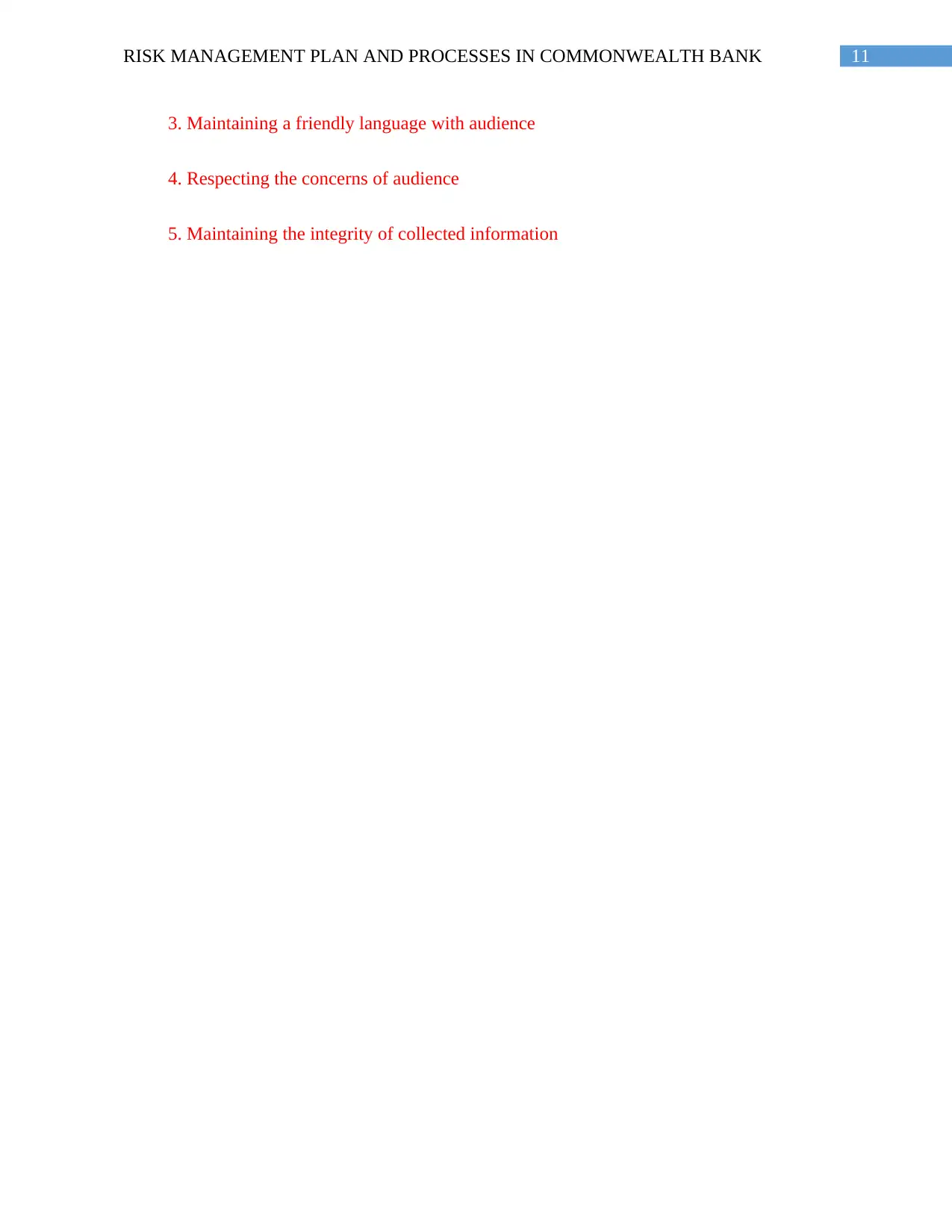
11RISK MANAGEMENT PLAN AND PROCESSES IN COMMONWEALTH BANK
3. Maintaining a friendly language with audience
4. Respecting the concerns of audience
5. Maintaining the integrity of collected information
3. Maintaining a friendly language with audience
4. Respecting the concerns of audience
5. Maintaining the integrity of collected information
⊘ This is a preview!⊘
Do you want full access?
Subscribe today to unlock all pages.

Trusted by 1+ million students worldwide
1 out of 15
Related Documents
Your All-in-One AI-Powered Toolkit for Academic Success.
+13062052269
info@desklib.com
Available 24*7 on WhatsApp / Email
![[object Object]](/_next/static/media/star-bottom.7253800d.svg)
Unlock your academic potential
Copyright © 2020–2025 A2Z Services. All Rights Reserved. Developed and managed by ZUCOL.





